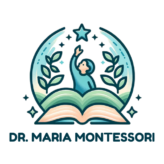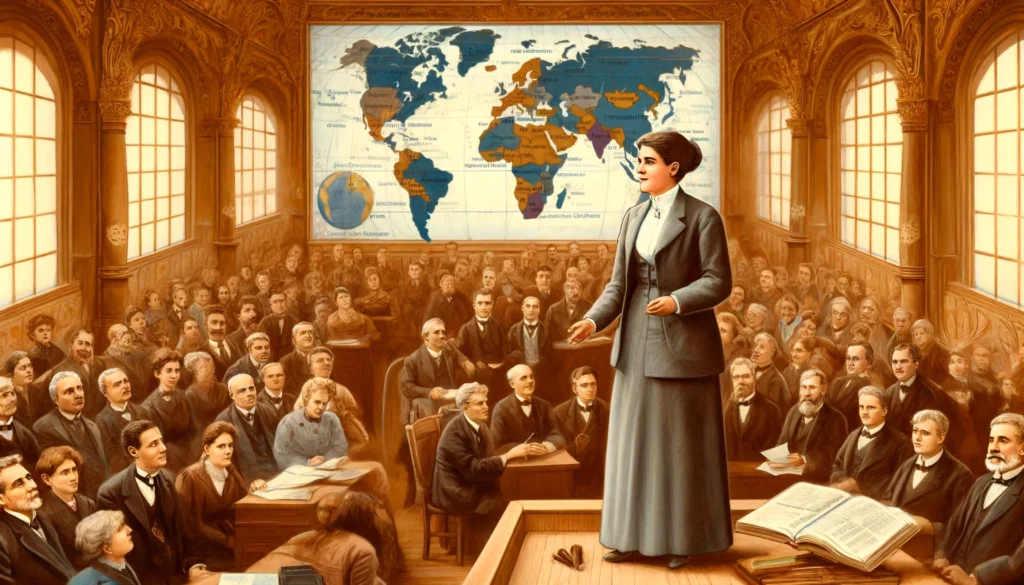Maria Montessori, an Italian physician and educator, revolutionized early childhood education with her innovative approach. Her methods emphasized respect for a child’s natural psychological development and fostered independence through a prepared environment. By the early 20th century, Montessori’s educational philosophy began to garner international attention, leading to widespread adoption and the establishment of Montessori schools around the world. This article delves into the period from 1909 to 1915, highlighting the international recognition and growth of Montessori education during these transformative years.
Early International Interest
By 1909, Montessori’s work had already attracted international observers and visitors. Her educational methods, which she meticulously detailed in her writings, began to spread rapidly beyond Italy. The publication of her book, “Il Metodo della Pedagogia Scientifica Applicato All’Educazione Infantile Nelle Case Dei Bambini” (The Method of Scientific Pedagogy Applied to the Education of Children in the Children’s Houses), played a crucial role in disseminating her ideas.
The book’s success was not confined to Italy. In 1912, it was published in the United States as “The Montessori Method: Scientific Pedagogy as Applied to Child Education in the Children’s Houses,” where it quickly became a bestseller. British and Swiss editions soon followed, and by 1913, Russian and Polish editions were available. By 1914, Montessori’s works had been translated into German, Japanese, and Romanian, with Spanish, Dutch, and Danish editions appearing in subsequent years. This widespread publication ensured that Montessori’s educational philosophy reached a global audience, setting the stage for international adoption.
Adoption in Europe
By the end of 1911, Montessori education had been officially adopted in public schools in Italy and Switzerland and was planned for the United Kingdom. Montessori’s methods were seen as revolutionary, offering a new approach to early childhood education that emphasized self-directed activity, hands-on learning, and collaborative play. In 1912, Montessori schools had opened in Paris and other major Western European cities. Plans were underway to establish Montessori schools in Argentina, Australia, China, India, Japan, Korea, Mexico, Switzerland, Syria, the United States, and New Zealand.
Public programs in cities like London, Johannesburg, Rome, and Stockholm began integrating Montessori methods into their school systems. The rapid spread of Montessori education in Europe was facilitated by the establishment of Montessori societies, such as the Montessori Society for the United Kingdom and the Montessori American Committee in the United States.
Montessori in the United States
Montessori’s work gained significant traction in the United States in 1911 and 1912, thanks in part to a series of articles published in McClure’s Magazine. These articles introduced Montessori’s methods to a broad American audience, sparking widespread interest and enthusiasm. The first North American Montessori school was opened in October 1911 in Tarrytown, New York. This initial success was followed by the establishment of another school by the famous inventor Alexander Graham Bell and his wife, who became ardent supporters of the Montessori method. They opened a second Montessori school in their Canadian home, further promoting the educational approach in North America.
The Montessori Method book sold quickly, going through six editions in a short period, which reflected the growing interest in her educational philosophy. The first International Training Course in Rome in 1913 was sponsored by the American Montessori Committee, highlighting the significant involvement of American educators in the Montessori movement. Of the 83 students who attended this course, 67 were from the United States, underscoring the country’s burgeoning interest in Montessori education.
By 1913, there were more than 100 Montessori schools in the United States. Montessori’s three-week lecture tour in December 1913, which included films of her European classrooms, drew large, enthusiastic crowds across the country. Her visit further cemented her influence and popularity in the U.S., with many educators and parents eager to adopt her methods.
In 1915, Montessori returned to the United States, sponsored by the National Education Association, to demonstrate her work at the Panama–Pacific International Exposition in San Francisco, California. A glass-walled classroom was installed at the exposition, allowing thousands of observers to watch a class of 21 students engaging in Montessori activities. This demonstration was a resounding success, showcasing the effectiveness of Montessori’s methods to a wide audience.
However, Montessori’s educational approach also faced opposition and controversy in the United States. Influential progressive educator William Heard Kilpatrick, a follower of American philosopher and educational reformer John Dewey, wrote a critical book titled “The Montessori Method Examined.” Kilpatrick’s critique, which dismissed Montessori’s methods as outdated and overly rigid, had a broad impact. Additionally, the National Kindergarten Association and other critics argued that Montessori’s approach relied too heavily on sense-training and left insufficient room for imagination, social interaction, and play.
Montessori’s insistence on maintaining tight control over the elaboration of her method, the training of teachers, the production and use of materials, and the establishment of schools also became a source of conflict. After Montessori left the United States in 1915, the Montessori movement in the country fragmented. Montessori education remained a negligible factor in American education until it experienced a revival in 1952.
Further International Development (1915-1939)
After her success in the United States, Montessori returned to Europe in 1916 and took up residence in Barcelona, Spain. Over the next two decades, Montessori traveled extensively, giving lectures and conducting teacher training courses throughout Europe. Her educational methods experienced significant growth in Spain, the Netherlands, the United Kingdom, and Italy.
Spain (1915-1936)
In Barcelona, a small program sponsored by the Catalan government in 1915 developed into the Escola Montessori, serving children from three to ten years old. This program included the Laboratori i Seminari de Pedagogia, a research, training, and teaching institute. A fourth international training course was held in Barcelona in 1916, introducing new materials and methods for teaching grammar, arithmetic, and geometry to elementary school children.
In 1917, Montessori published her elementary work, “L’autoeducazione nelle Scuole Elementari” (Self-Education in Elementary School), which was later translated into English as “The Advanced Montessori Method.” Around 1920, the Catalan independence movement began to demand that Montessori take a political stand, which she refused. Consequently, official support for her programs was withdrawn. Despite these challenges, Montessori’s work continued to thrive in Barcelona until the onset of the Spanish Civil War in 1936, which forced her to leave Spain permanently.
Netherlands (1917-1936)
Montessori’s influence in the Netherlands began in 1917 when she lectured in Amsterdam. The Netherlands Montessori Society was founded shortly after her visit. Montessori returned to the Netherlands in 1920 to give a series of lectures at the University of Amsterdam. By the mid-1930s, Montessori programs flourished in the Netherlands, with over 200 Montessori schools established throughout the country. In 1935, the headquarters of the Association Montessori Internationale (AMI) moved permanently to Amsterdam, solidifying the Netherlands as a central hub for Montessori education.
United Kingdom (1919-1936)
Montessori education initially met with both enthusiasm and controversy in the United Kingdom between 1912 and 1914. In 1919, Montessori visited England for the first time and conducted an international training course that generated significant interest. Despite some struggles over authenticity and fragmentation, Montessori education continued to spread in the UK. Montessori returned to England every other year until the beginning of World War II to give training courses, further solidifying her influence in the country.
Italy (1922-1934)
In 1922, Montessori was invited to Italy on behalf of the government to give a series of lectures and inspect Italian Montessori schools. Later that year, Benito Mussolini’s Fascist government came to power, and Montessori returned to Italy to plan annual training courses under government sponsorship. By 1924, Mussolini extended his official support for Montessori education, integrating it into the national program. The Societa gli Amici del Metodo Montessori (Society of Friends of the Montessori Method) became the Opera Montessori, a government-chartered organization, with Mussolini as its honorary president.
However, by the 1930s, Montessori and the Italian government began to conflict over financial support and ideological issues, particularly after Montessori’s lectures on Peace and Education. By 1932, Montessori and her son Mario were placed under political surveillance. In 1933, Montessori resigned from the Opera Montessori, and by 1934, she left Italy. The Italian government ended Montessori activities in the country in 1936.
Other Countries
Between 1913 and 1936, Montessori lectured and established schools and societies in numerous countries, including France, Germany, Switzerland, Belgium, Russia, Serbia, Canada, India, China, Japan, Indonesia, Australia, and New Zealand. Her lectures in Vienna in 1923 were published as “Il Bambino in Famiglia,” later translated into English as “The Child in the Family.”
The Association Montessori Internationale (AMI)
In 1929, Montessori and her son Mario founded the Association Montessori Internationale (AMI) during the first International Montessori Congress in Elsinore, Denmark. AMI was established to oversee the activities of Montessori schools and societies worldwide and to supervise the training of teachers. The organization also controlled the publication rights to Montessori’s works and the production of authorized Montessori didactic materials. Early sponsors of AMI included Sigmund Freud, Jean Piaget, and Rabindranath Tagore.
Peace Advocacy
In 1932, Montessori spoke on “Peace and Education” at the Second International Montessori Congress in Nice, France. Her lecture emphasized the role of education in achieving lasting peace and was published by the Bureau International d’Education in Geneva, Switzerland. Montessori continued to hold peace conferences throughout Europe, which were later published as “Educazione e Pace” (Education and Peace). She was nominated for the Nobel Peace Prize three times, in 1949, 1950, and 1951.
Later Years and Legacy
In 1936, Montessori moved to Laren, near Amsterdam, where she and her son Mario continued to develop new educational materials. Amid rising military tensions in Europe, Montessori increasingly focused on peace education. The 6th International Montessori Congress in 1937 centered on “Education for Peace,” with Montessori advocating for a “science of peace” and the role of education in societal reform. In 1938, she was invited to India by the Theosophical Society to conduct a training course, and in 1939, she left the Netherlands for India with her son Mario.
Maria Montessori’s work during the years of international recognition and growth from 1909 to 1915 laid the foundation for a global educational movement. Her innovative methods, commitment to peace, and dedication to the holistic development of the child have left an enduring legacy. Today, Montessori schools can be found worldwide, continuing to inspire and educate children according to the principles she established over a century ago.

